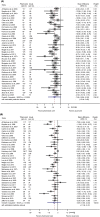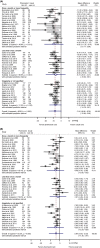Improving blood pressure control through pharmacist interventions: a meta-analysis of randomized controlled trials
- PMID: 24721801
- PMCID: PMC4187511
- DOI: 10.1161/JAHA.113.000718
Improving blood pressure control through pharmacist interventions: a meta-analysis of randomized controlled trials
Abstract
Background: Control of blood pressure (BP) remains a major challenge in primary care. Innovative interventions to improve BP control are therefore needed. By updating and combining data from 2 previous systematic reviews, we assess the effect of pharmacist interventions on BP and identify potential determinants of heterogeneity.
Methods and results: Randomized controlled trials (RCTs) assessing the effect of pharmacist interventions on BP among outpatients with or without diabetes were identified from MEDLINE, EMBASE, CINAHL, and CENTRAL databases. Weighted mean differences in BP were estimated using random effect models. Prediction intervals (PI) were computed to better express uncertainties in the effect estimates. Thirty-nine RCTs were included with 14 224 patients. Pharmacist interventions mainly included patient education, feedback to physician, and medication management. Compared with usual care, pharmacist interventions showed greater reduction in systolic BP (-7.6 mm Hg, 95% CI: -9.0 to -6.3; I(2)=67%) and diastolic BP (-3.9 mm Hg, 95% CI: -5.1 to -2.8; I(2)=83%). The 95% PI ranged from -13.9 to -1.4 mm Hg for systolic BP and from -9.9 to +2.0 mm Hg for diastolic BP. The effect tended to be larger if the intervention was led by the pharmacist and was done at least monthly.
Conclusions: Pharmacist interventions - alone or in collaboration with other healthcare professionals - improved BP management. Nevertheless, pharmacist interventions had differential effects on BP, from very large to modest or no effect; and determinants of heterogeneity could not be identified. Determining the most efficient, cost-effective, and least time-consuming intervention should be addressed with further research.
Keywords: hypertension; pharmacist; prediction interval; systematic review; team‐based care.
Figures



References
-
- Lawes CM, Vander Hoorn S, Rodgers AInternational Society of Hypertension. Global burden of blood pressure‐related disease, 2001. Lancet. 2008; 371:1513-1518 - PubMed
-
- U.S. Preventive Services Task Force. Screening for high blood pressure: U.S. Preventive Services Task Force reaffirmation recommendation statement. Ann Intern Med. 2007; 147:783-786 - PubMed
-
- Gu Q, Burt VL, Dillon CF, Yoon S. Trends in antihypertensive medication use and blood pressure control among United States adults with hypertension: the National Health and Nutrition Examination Survey, 2001 to 2010. Circulation. 2012; 126:2105-2114 - PubMed
-
- Wolf‐Maier K, Cooper RS, Kramer H, Banegas JR, Giampaoli S, Joffres MR, Poulter N, Primatesta P, Stegmayr B, Thamm M. Hypertension treatment and control in five European countries, Canada, and the United States. Hypertension. 2004; 43:10-17 - PubMed
Publication types
MeSH terms
Substances
Grants and funding
LinkOut - more resources
Full Text Sources
Other Literature Sources
Medical
Research Materials
Miscellaneous

